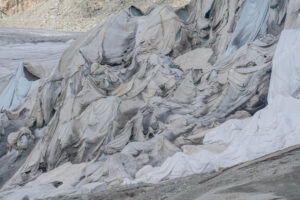
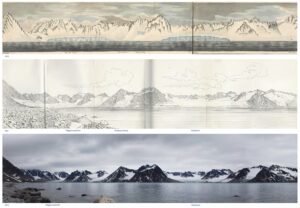
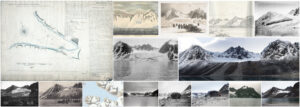
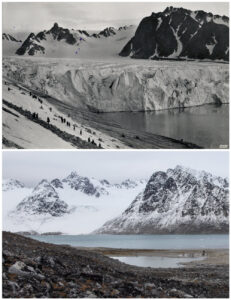
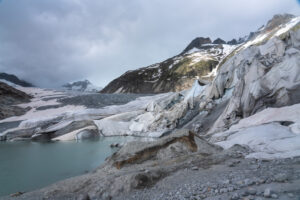
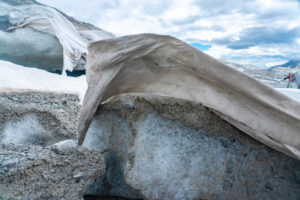
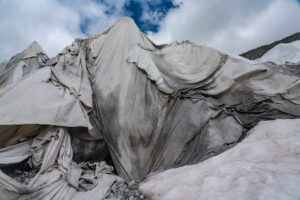
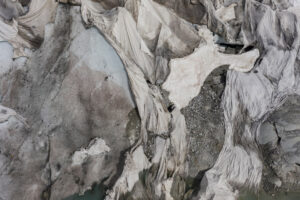
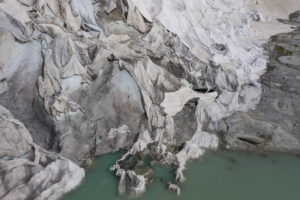
Chasing reality and dealing with crisis through photography - the image, the artist and the environment




I was first fascinated by Eliasson’s project but soon became skeptical and started to think about sustainability in art. I asked myself if we actually are allowed to do anything in the name of art, or are we not losing our credibility by making a project about global warming and at the same time produce a huge unessential carbon footprint? There were definitely other ways to emphasis the problem without a huge waste of resources. The same critic goes to those who fund projects that don’t seem sustainable. It seems that producing pieces of ice, or even bring the ice from a glacier in Norway, would have been more sustainable than bringing ice all the way from Greenland. Knowing the colonial history of Denmark and the colonized Greenland, it translates in how colonialism contributes to the subject. The idea of being of possession of resources of some place occupied that wouldn’t naturally belong to Denmark. But the question again: How much does this contribute to the story of climate change and melting glacier? By looking at other projects from the same artist that are not environmental related, like the new bridge in Copenhagen where he emphasized in using certain type of wood from Brazil instead of using wood from a neighboring country. It creates a doubt about the artists credibility for many viewers. Considering the Ice Watch projects sustainability, the only thing I could find on how the artist explains that the co2 emission of his project is the same of a school class taking a flight to somewhere in Europe. Which again to me contradicts the aim of the project. According to Eliasson, he wants to change the world through his actions, he is aware of the climate change. He is also concerned about the rain forests in Brazil and also about people in Africa that lack access to electricity.



At the moment there is a high demand at the moment for such environmental projects and blend the use of photography more in research in order to communicate the problem better and enhance the message visually.

Tyrone Martinsson is deeply involved and dedicated to his long-term projects, which makes him deeply involved in the subject he is treating and understand how to approach it, to extract the right expression. Without a grounded curiosity and commitment to the subject, it’s hard to maintain such extensive projects. His choice of locations where his projects are taking place comes from a good understanding of the historical roots of the place and how people can relate to it. The use of the archival image and extend it by revisiting works multidimensional in combining the past with the present, that doesn’t only illuminate the change over time but it makes this change measurable. In Martinsson’s project Svalbad it’s not about finding a new angle to photograph a scenic landscape, it’s more about a follow up of the archival image that already exists. In his project with Per Hulmlund that turned out to be a book Frusna Ögonblick, Svenk Polarfotagrafi 1861–1980” (Frozen Moments, Swedish Polar Photography 1861–1980) he could demonstrate the difference clearly, and the effect of climate change based on his work and research in relation to the archival image.

Tyrone answered to this question reflecting on Olafur Eliasson’s work: “I admit he is an artist I like. The works Ice Watch is of course surrounded by ethical aspects of its realization and its use of a lot of energy and fossil fuel gathering the ice in Greenland and transporting it i cooler containers and throughout other means. His purpose and agenda is good though. I agree with him as he argue that a more perhaps provocative attitude is needed to raise attention to the problem and as most peoples have not come close to a glacier this symbolic melting of quite large chunks of ice might be a way towards a great awareness.”
Tyrone Martinsson’s sees that the environmental art scene has developed a lot in the way how many artists work with these issues and collaborate with other disciplines and how their work is framed and presented, thinking of artists like Diane Burko, Anna McKee, Jonathan Kay, Jeroen Toirkens and Anne Noble. Tyrone Martinsson thinks in general though that artists suffer from the same problem of communicating their works and what they really want their works to do. We share this with science and could be much better focused on that. He believes we have to work more together and also with institutions such as museums, libraries and other public spaces. This is a great challenge and the art market is better on handling this than any other commercial part of our global economy.
In research groups with Multidisciplinary, like Tyrone’s research group and in many other networks concerned about the environment there is a question that is being raised if an artist should travel to do environmental projects and wether it’s better to let local artists deal with the environmental subjects on location. I think that might have a minimal effect in the end, since scientists and research groups also travel to remote places, in order to get more information that could help us understand our problems and try to find a potential solution. However, we still need creative people to communicate the findings from scientists and researchers. It’s important and carry the agency of informing the public about what is actually going on. One can think of the war photographers who visit the battlefields and their role to deliver and document what is happening there.
Tyrone Martinsson commented on the subject: “I do believe we need to travel sometimes. One reason for me is that what I am currently involved with is part documenting a place rapidly changing and the changes will stay that way for many generations to come. We document what is still left of an Arctic landscape that we have taken for granted for hundreds of years and we also in the process set up a monitoring base for the future. However, we are concerned with how we go about. We try to minimize our impact in the field. We have also learned that we don’t have to travel to plan things or to just meet. I want to try to stay within Scandinavia as much as I can. I try to avoid unnecessary flying. There are groups that think we should stop going to remote places. We do also have some possibilities via new technologies such as advanced satellite monitoring but that’s not close to be able to work from the ground. I believe that we all have to think about this part of our work be it from an artist perspective or research. I try to evaluate the art presenting it self as environmental based on its intentions. I think there is an art scene growing where we see artists that genuinely work with these questions and will probably do so in the future. We see special initiatives in different art spaces for exhibitions on this theme but I think we can ask how all public spaces and particularly those with governmental funding should think and act along the lines of sustainability and in relation to the environmental challenges we are facing but also our relation to nature as the foundation for our existence.”
In her trilogy project (2013–2016) Ester Vonplon also dealt with the problem of melting glaciers. Her project started basically from the front of the door of her house; as a Swiss artist she didn’t have to travel far to find what she was looking for. Ester Vonnplon, who studied in Zürich and Berlin and now works in Chur and Castrisch, reveal a vanishing world in her project, and the desperate attempt to counteract the effect of climate change. The tripartite project is composed of Gletscherfahrt (Glacial Movement), from 2013, Wohin geht all das Weiss, Wenn der Schnee schmilzt (Where All The White Goes When The Snow Melts), created between 2013 and 2014, and Wie viel Zeit bleibt der Endlichkeit (How Much Time Remains of Finitude), her most recent work from 2016.
Ester Vonplon heard that people covering a glacier in Switzerland with sheets to slow down the melting process. But the artist was not traveling for that exactly in mind, she wanted to visit the snowy mountains in summer to take photos, then she stumbled upon this glacier covered with sheets where she was not convinced about the practicality and effect it does. The scene triggered mixed feelings in the artist. She was touched by the scene and even-though it’s a sad one, she could find a beauty in it. Ester Vonplon mentioned that it got her thinking about the process of dying, and the way we cover dead bodies with a white sheet. This was consistent with a recurring theme in her work about disappearing things. The glaciers are part of a world which is quickly going away.
In my new project Endzeit, which took place in the same location, I ironically didn’t recognize in the beginning that it was the same location she photographed in her project. I had similar feelings, I felt sad, I stood there still and though about humanity, about our lifestyle and how one feels tiny against this amazing glacier. I have never been to this part of Switzerland before, but I felt like somehow the glacier was like an old friend. I felt a connection. I could hear a silent screaming of someone asking for help, asking to stop the whole insanity and stupidity going on in this world, asking us to come back to our senses and consider the mass production cycle we all have become a part of. Where it’s all about saving money and making profit. I felt that this friend is saying a farewell and will soon be gone. I could feel that the glacier is living with a soul and feelings.
Unlike the work of Tyrone Martinsson and Klaus Thymann, Ester Vonplons work is more abstract and less of a typical documentation. The images by nature are documenting the event and the happening with more focus on the abstractness of the awkwardness of the scene. Her work isolates the subject from its surrounding, a classical characteristic of the camera. By looking at the images which mostly shows the piece of cloth covering the glaciers, I had to think about ghosts. Under the cloth is something that is unreachable, forbidden for the eye or in its way to vanish or become invisible. The photographs are surreal and real in the same time, and they remind me of photographs of the late 19th century and develop a nostalgic feeling in a way. The photograph rendered the reality and transformed it to something different, and are telling something poetic in a melancholic and intimidating way. Ester Vonplon worked cross disciplinary in this project by recording the sound of the melting glacier under the cover, you could hear the melting drops clearly.
In 2016 Ester Vonplon documented the melting of glacier in Spitzbergen, in Svalbard, in order to collect impressions about the melted ice and vanishing glaciers. It was not so far from the working site for Tyrone Martinsson’s project mentioned earlier. She could turn the glaciers covered with cloth into an artwork, even though the black and white here gives it a darker feeling of sadness, which in the end serves the subject. Using sound as an evidence of the melting, and endorse this in a piece in cooperation with a composer, is also a something that makes her project stands out. She tries to reach different kinds of audiences, which is great in order to raise attention to the subject. Her trilogy has been published as a photobook with Stephan Eicher by bFrank Books with the title When the glaciers melt, will we melt then too?. A big part of Ester Vonplon’s work could be seen as photo books, and she obviously plans her projects with the idea in mind how they would communicate in a book which serves a slightly different target of audience.
After seeing the projects from Ester Vonplon and Thomas Wreder. I started reading about the subject of covering glaciers and it was my curiosity that was pushing me to go there. I wanted to see and feel the location, especially that I had my exchange semester in Zürich and I lived in Switzerland before as well I had a different connection and association to the subject in a personal level. I was not sure if it’s advocating for a reckless act like covering glacier with huge sheets which brings the questions of what is the co2 emission and cost for the production of these sheets. When asking the scientist Keith Larson which is located in the Abisko climate station, north of Sweden, In his words; “it’s plain stupid,…”
After doing some research I stumbled upon the word “Snow Farming”, a friend from Austria told me that they cover parts of the glaciers in summer and store the cover in winter, that is also proven to be successful and fundamental for the survival of the ski resorts on the Alps. The process happens by collecting the snow that still remain in April and pile it up and then cover it with foils or foam plates. The cost for the sheets and maintaining them is 2 Euros per m², the remaining question is who is going to finance it stays open. It’s said that the sheets helped reducing the melting of the glacier in summer by 70%.
The glacier in Switzerland has a long history and special meaning for the Swiss people, since 150 years tourists visit the glacier and it’s ice cave, The history of Rhone glacier has been photo archived since the 19th century and the images could be seen at the “Gletscherarchiv”, its importance lies beyong being a violated motiv for photos for tourists since 150 years, but it lies also in the demographic and economical change it brings by its disappearance, as the glacier is the water source for the region and also other bordering countries, beside the income loss due to the disappearance of the glacier tourists, that could be seen in some of the hotels that is now closed since years. The sheets are now partially swimming underwater in the lake of the melted glacier tongue. When I saw the glaciers situation with the sheets, it triggered different feelings and impressions in me. I went there and took photos and made aerial videos, I was looking at the glacier and the glacier was watching me. This location is well known from the movie of James Bond. It might sound strange for some people but I actually haven’t seen the James Bond movies, especially those from the 60’s. After looking at those moving images and the images I have taken I must say, it’s a catastrophic development in such a very short period of time.
The environmental photography scene has developed a lot during the recent years, more and more photographers and artists are getting involved in the subject. The art scene might be capable of doing what the other institutions failed to achieve. Especially photography has a great potential in raising awareness towards this vital subject. The photographic medium with its vivid characteristic is already winning more artists on its side daily that are willing to change and start a dialogue with their art to save at least a part of the planet and reduce the damage. Photography could be used as an educative tool towards the public that can shift lifestyle and way of thinking. Tyrone Martinsson’s different methods of rephotography and use of archive are powerful, they communicate history and present with the viewer and more artists are using similar methods like Mark Klett. The sustainability of the art itself is important and the question about it is being raised between artists and scientists, in the mean time some other groups see provocation and controversy as an approach that could make the impact that one wishes for, despite it’s environmental high cost. It’s also about the region the artist is active at, some decide to deal with their own environment and avoid unessential traveling by plane where it’s possible. It could be inevitable though to avoid it completely especially on field studies, art and multidisciplinary projects that acquire tracking of ongoing change as an example. Photography and moving image can and will make quite extensive impact on how the problem of climate change is articulated and communicated. Using different kinds of photography definitely helps to reach out to wider spectrum of people.
Reference List:
– Adele Peters, Fastcompany.com, interview with Olafur Eliasson, published 29.10.2014
– Dorothea Cremer-Schacht Qoutein Südkurrier, [stephanwitschi.ch/en/stephan-witschi/artists/ester-vonplon.html]stephanwitschi.ch/en/stephan-witschi/artists/ester-vonplon.html, visited 08.12.2020
– Jack French, [lensculture.com/articles/ester-vonplon-gletscherfahrt-beyond-the-visual]lensculture.com/articles/ester-vonplon-gletscherfahrt-beyond-the-visual, interview with E Vonplonn, visited 08.12.2020
– [Klausthymann.com/projects/project-pressure/#0]Klausthymann.com/projects/project-pressure/#0, visited in 08.12.2020
– [Lomography.de/magazine/332577-frozen-observations-an-interview-with-ester-vonplon]Lomography.de/magazine/332577-frozen-observations-an-interview-with-ester-vonplon, interview with E. Vonplonn, visisted 0812.2020
– Pia Siri Isaksson, [verktidskrift.se/bilder-om-bergets-tankar]verktidskrift.se/bilder-om-bergets-tankar, interview, published 01.07.2019
– [Thomas-wrede.de/de/photography/glaciers-projects-outside-_inside]Thomas-wrede.de/de/photography/glaciers-projects-outside-_inside
– Tyrone Martinsson & Per Holmlund, Frusna Ögonblick, Svensk Polarfotografi 1861-1980, 2017
Image 1. Armand Tamboly, Rhone glacier covered with blankets to keep it from melting in summer, Furka pass, Switzerland.
Image 2. Tyrone Martinsson, Sydkusten Panorama Magdalenefjorden.
Image 3. Tyrone Martinsson, HangingGlacier, Magdalenefjorden, Collage 2019.
Image 4. Tyrone Martinsson, Gullybreen 1930/2016.
Image 5 – 7. Armand Tamboly, Rhone glacier covered with blankets to keep it from melting in summer, Furka pass, Switzerland.
Image 8-9. Armand Tamboly, Aerial of Rhone glacier in Valais.
Reference for other images:
https://estervonplon.net/work/gletscherfahrt-2013-2015 (Links to an external site.)
https://estervonplon.net/work/wieviel-zeit-bleibt-der-endlichkeit-2016 (Links to an external site.)
https://olafureliasson.net/archive/artwork/WEK109190/ice-watch